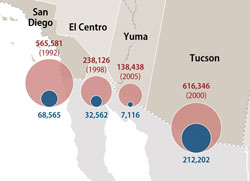The common political debate over how the United States needs to “secure its borders” — particularly ahead of any negotiation over immigration reform — implies, of course, that the country’s borders aren’t all that secure. Increasingly desperate state laws attempting to curb illegal immigration reinforce the notion, as have highly publicized individual incidents, both real and imagined.
In addition, as drug violence has escalated along the Mexican side of the border, it’s easy to see why concerned U.S. residents would make the cognitive step from the reality of rising violence in Mexico to the fear of a rising immigration problem in the U.S.
This perception, though, contradicts what has occurred on the ground at the border over the last two decades. Today, America’s southern perimeter is more secure than it’s ever been, the result of an 18-year buildup, spanning three presidential administrations, of resources, manpower, infrastructure and technology. Homeland Security officials have tried to argue this point. USA Today found that crime rates at the U.S.-Mexico border were lower than the U.S. national average. And a new report from the left-leaning Center for American Progress — suggestively titled “Safer Than Ever: A View from the U.S.-Mexico Border, Assessing the Past, Present, and Future” — documents the evolution in detail.
The economy has undoubtedly played a significant role in slowing immigration over the last several years. When the economy rebounds and the lure of jobs reappears, this recent trend will likely shift. But since the early 1990s, the long-term evolution of the border has been a story of stricter enforcement and more security.
“It was a radically different geography,” Marshall Fitz, author of the Center for American Progress report, said of the scene at the southern border 20 years ago. “For someone who’s spent time there many years ago, in the early ’90s, as well as having seen at least parts of its evolution over the last 18 years, I can say that it’s really unrecognizable in many respects.”
Today, the 2,000-mile border has 650 miles of fencing, where 25 years ago it had virtually none (although some candidates like Michele Bachmann would prefer the whole border fenced off). Ten years ago, America spent about $4 billion a year on border and immigration enforcement at its land borders. Now that figure is about $17 billion. In 2004, there were 10,000 Border Patrol agents in the U.S. Now there are 21,000, about 18,000 of them deployed to the U.S.-Mexico border.

Miller-McCune’s Washington correspondent Emily Badger follows the ideas informing, explaining and influencing government, from the local think tank circuit to academic research that shapes D.C. policy from afar.
Those law enforcement officials also have technology tools that were never available to them before, from mobile surveillance units to thermal imaging systems to aerial drones (not the kind the U.S. deploys in Afghanistan, that is, although presidential hopeful Rick Perry floated that idea this week).
“You could have crossed and crossed back and crossed and crossed back many, many times along many parts of the border without anyone ever knowing,” Fitz said of 20 years ago. “That’s something that’s just changed so dramatically.”
As a result, he points to what seems like a counterintuitive data set: Apprehensions of illegal immigrants are dramatically down at the border. As with any similarly focused law enforcement strategy, he says, we’d first expect to see apprehensions rise. But then that number reaches a peak and begins to decline along a kind of bell curve, as the rising costs of risking immigration deter would-be immigrants.
Today, apprehensions are down — for instance, from more than 565,000 in 1992 in the San Diego region to about 68,000 there last year — but law enforcement is also able to say with more accuracy that today’s apprehensions represent a higher percentage of the total number of people attempting to cross the border. “They have a much, much [more] clear sense of the denominator,” Fitz said, thanks to the expansion in manpower and technology. He says Border Patrol in many regions now put the apprehension figure at more than 80 percent.

Graphic shows how border apprehensions have decreased between 2000 and 2010.
(Source: Center for American Progress)
To some, that may still not mean “secure.”
“They’re not going to get to 100 percent apprehension ever,” Fitz responded. “I don’t think that’s a smart or reasonable goal. I think it would be a massive waste of resources to continue to try to get to that point. They’ve already gone beyond the point of diminished returns.”
Consider, he suggests, the Berlin Wall, which was never a completely effective seal. People still managed to escape — and, theoretically, it should be easier to keep people in a place than out of one.
“This is all about degrees, and unfortunately, the debate is never about degrees,” Fitz said. “The debate is about absolutes: ‘The border isn’t secure, we’ve got to secure the border first.’ Well, the border is far more secure than it’s ever, ever, ever been, unquestionably.”
Which raises another question that really troubles Fitz: Why doesn’t this history penetrate public debates about the border?
Sign up for the free Miller-McCune.com e-newsletter.
“Like” Miller-McCune on Facebook.
Follow Miller-McCune on Twitter.
Add Miller-McCune.com news to your site.





